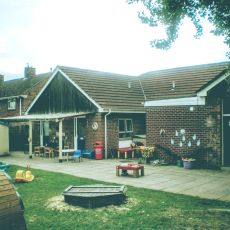The Nursery comprises four rooms split between two buildings on one large site. A range of stimulating activities using a wide variety of carefully chosen resources, are provided for all children. These are designed to enable children to develop their fine and gross motor skills, to increase their vocabulary to enable them to express themselves confidently, and to stimulate their social, emotional and intellectual development. Each child is assigned a key-worker who is primarily responsible for their observations and record keeping whilst they are in the Nursery.
Children will visit a room that they are due to move to during the weeks prior to their transfer date to enable them to make the transition smoothly and confidently.
The two baby and toddler rooms, each catering for up to twelve children under two years-of-age, are known as The Nest and Fledglings respectively. The Nest caters for the younger babies from approximately six months whilst Fledglings offers learning and development opportunities for children up to two. With increased statutory maternity leave it is anticipated that both rooms will eventually cater mainly for children from approximately ten months to two years with just a few younger ones in The Nest. Both rooms embrace the guidance offered by the Department for Education in the Early Years Foundation Stage framework. A daily diary is completed for each child and made available to parents at the end of the day to enable them to monitor their child’s progress. Parents should also feed back to the Nursery, in conversation with the staff, important aspects or changes in life at home.
The room for two year-olds is known as The Riverbank. It can cater for up to twenty-four children who will usually transfer from Fledglings shortly after their second birthday. The Riverbank offers more structured activities and opportunities for learning through play using more complex resources. The children also learn to develop their social skills through interacting more with other children, learning to cooperate and starting to take account the needs of others. They will also acquire the basic knowledge and skills required to enable them to start to tackle the Foundation Stage of the National Curriculum with confidence.
The pre-school room for three to five year-olds is known as The Swannery. This also caters for up to twenty-four children. Here the children have a more structured environment. Through a mixture of play and instruction, the children work towards the desirable outcomes as set out in the Foundation Stage of the National Curriculum. By this stage they should have a lot more confidence and a degree of independence such that at certain times they are able to choose which resources they wish to use.












